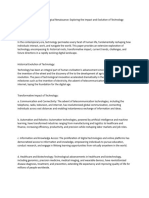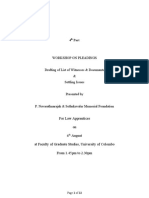0% found this document useful (0 votes)
43 views5 pagesTechnology Notes
The document provides an overview of technology, defining it as the application of scientific knowledge to solve problems and improve life quality. It discusses various types of technology, their historical evolution, and their impacts on society, including social, economic, and cultural aspects. Additionally, it highlights current trends, ethical considerations, and future directions in technology, emphasizing the importance of responsible use and the potential for collaboration between humans and machines.
Uploaded by
boom203Copyright
© © All Rights Reserved
We take content rights seriously. If you suspect this is your content, claim it here.
Available Formats
Download as TXT, PDF, TXT or read online on Scribd
0% found this document useful (0 votes)
43 views5 pagesTechnology Notes
The document provides an overview of technology, defining it as the application of scientific knowledge to solve problems and improve life quality. It discusses various types of technology, their historical evolution, and their impacts on society, including social, economic, and cultural aspects. Additionally, it highlights current trends, ethical considerations, and future directions in technology, emphasizing the importance of responsible use and the potential for collaboration between humans and machines.
Uploaded by
boom203Copyright
© © All Rights Reserved
We take content rights seriously. If you suspect this is your content, claim it here.
Available Formats
Download as TXT, PDF, TXT or read online on Scribd
/ 5


























































































